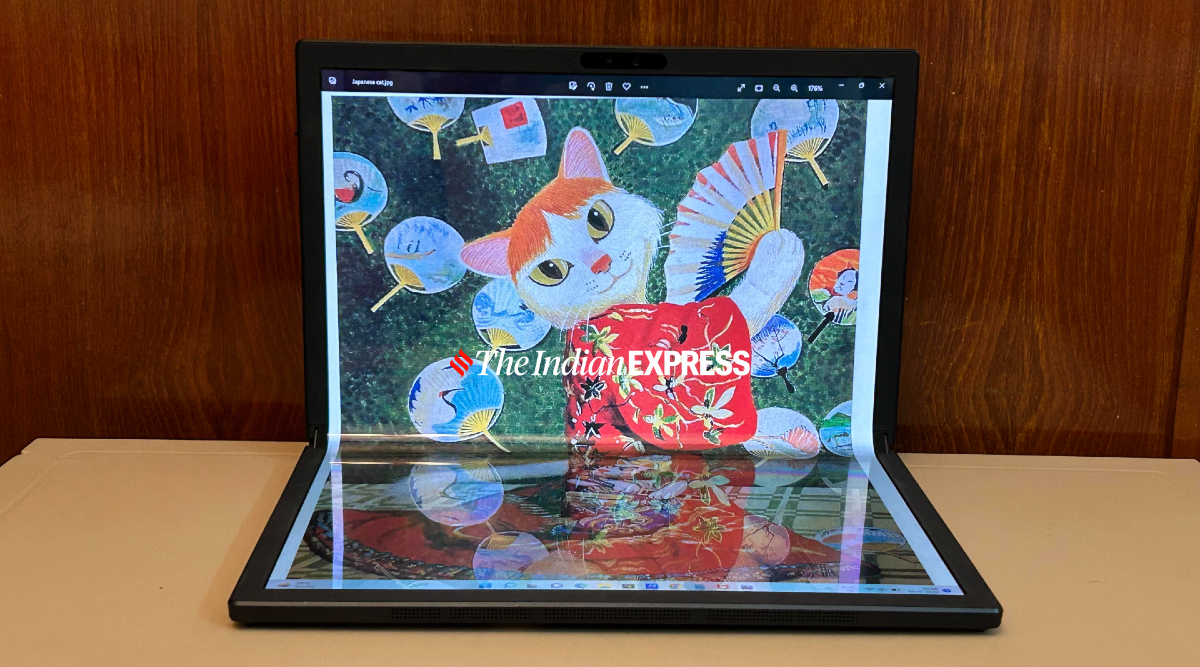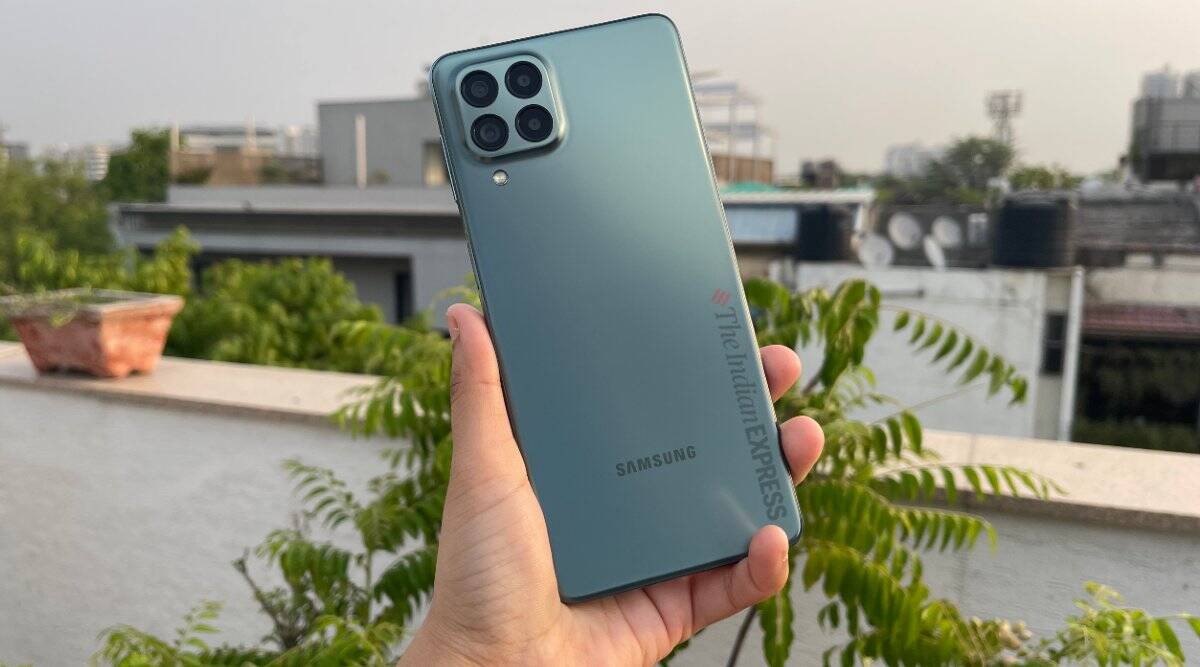I vividly remember an off-the-record discussion I had with a senior executive of a major PC brand in Las Vegas about the prospects of foldable PCs six years ago. Back then, no company had discussed foldable PCs publicly, let alone had plans to launch them commercially. But the way the executive previewed what you could do with a foldable laptop piqued my curiosity about the form factor. Years after seeing them as concepts, I have used a foldable laptop for only the second time. Made by Asus, the ZenBook 17 Fold OLED is a foldable laptop that lets users switch between a traditional clamshell notebook and a 17-inch all-in-one PC. I set aside my MacBook Air M1 and put faith in the ZenBook 17 Fold for a few days. Here’s how my perception changed about foldable laptops after using the ZenBook Fold as my daily computing driver.
Asus ZenBook 17 Fold price in India: Rs 3,29,990
An intense warning
The first thing you see as soon as you unbox the ZenBook Fold is a “care instruction” sheet. The device costs Rs 329,990 and Asus has several warnings on how to use it and take care of this. But this is also the case with Samsung’s Galaxy Z Fold, a foldable phone. For example, you will be warned: “do not exert pressure around the hinge area.” This in a way is a disclaimer telling users about how delicate the foldable screen on the ZenBook Fold is and that one should exercise caution when using the device.
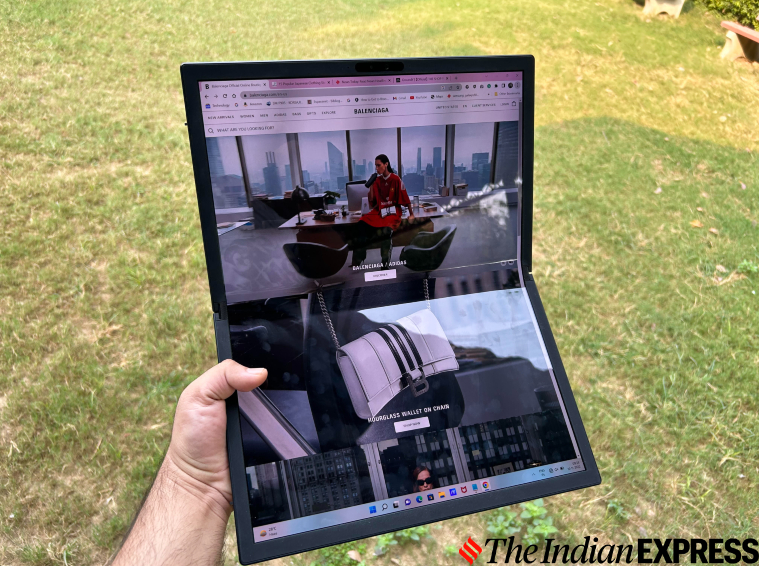 The 17-inch folding OLED display is amazing, though it is made of plastic and not glass. (Image credit: Anuj Bhatia/Indian Express)
The 17-inch folding OLED display is amazing, though it is made of plastic and not glass. (Image credit: Anuj Bhatia/Indian Express)
Using a foldable laptop in the real world
From day one, I was clear the ZenBook Fold would be my main work laptop and not a secondary computing device. So, I used the Fold exactly how I handle my MacBook Air. Over the course of testing, I let my colleagues open and close the Fold multiple times, swipe around the display and used the device as a tablet as well. Initially, I was a bit hesitant about the durability of the device. But I let my fears aside and adapted the ZenBook Fold to my everyday life.
I have opened and folded the device about 10 to 15 times a day, and the hinge should be good enough for years. I am confident that no one has to worry about hinge failure on the Fold. The one caution I do want to talk about is to avoid using a fingernail or anything sharp on the screen as it can damage the OLED display. One also has to be careful to make sure there are no major particles on the display when they close it.
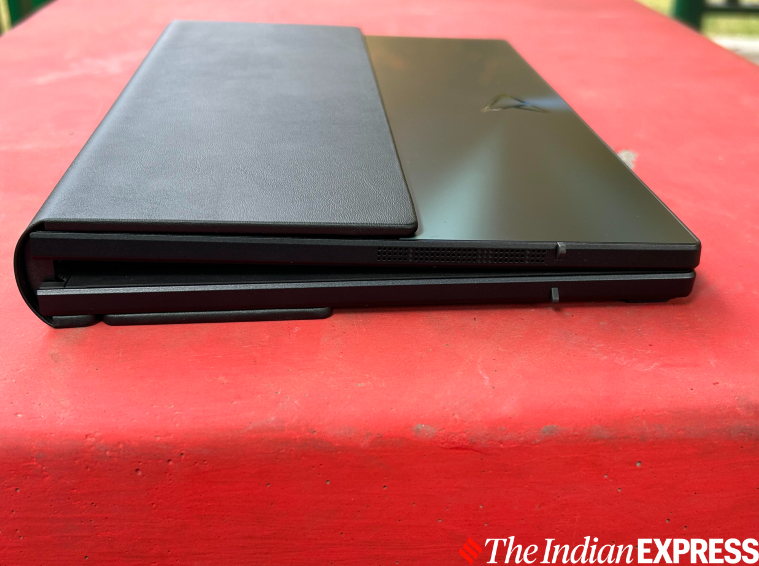
 The ZenBook Fold looks distinctive and has a unique design. (Image credit: Anuj Bhatia/Indian Express)
The ZenBook Fold looks distinctive and has a unique design. (Image credit: Anuj Bhatia/Indian Express)
Usability
The core difference between a traditional laptop and the ZenBook Fold is the ability to use the Asus device in different ways. When travelling for work or attending conferences I used the ZenBook Fold like a normal 12.5-inch clamshell laptop. This is possible due to a folding screen. The big, nice-looking 17-inch touch display folds in half and it can be instantly used in laptop mode. The whole experience didn’t translate into some cramped and difficult-to-use laptop which was the case with the Lenovo ThinkPad X1 Fold. With this laptop not only do I get a display that’s sharp and vivid, but I also have the freedom to transform the device the way I want.
The included keyboard magnetically attaches to the lower half of the display for a classic laptop mode. The keyboard is comfortable to type on with plenty of travel. As a writer, I feel the typing experience needs to be front and centre for any keyboard. The keys aren’t backlit though. The touchpad, too, is decent. While the Bluetooth keyboard may seem like the perfect fit, it makes the device thick and heavy when folded.
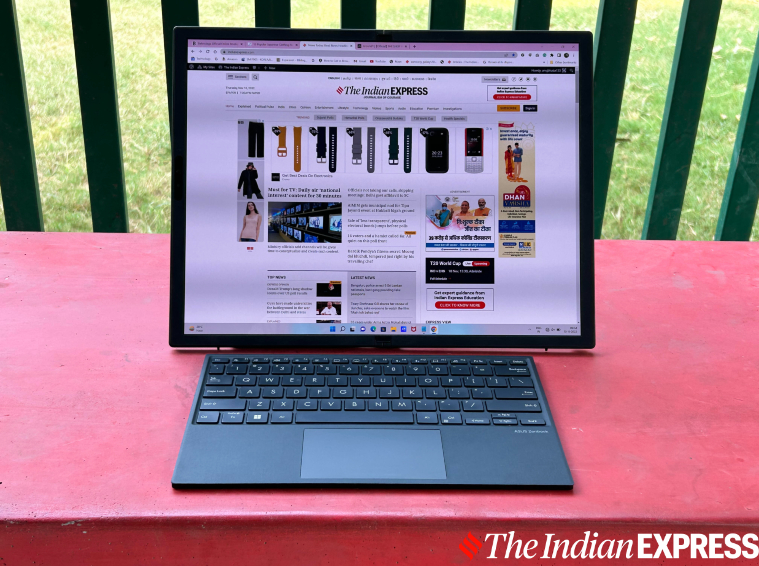
 I used the All-in-one desktop mode a lot during testing. (Image credit: Anuj Bhatia/Indian Express)
I used the All-in-one desktop mode a lot during testing. (Image credit: Anuj Bhatia/Indian Express)
My favourite way of using the ZenBook Fold has to be the all-in-one PC mode. I used the desktop mode a lot when I worked in the office. When placed on an appropriately flat surface—thanks to a built-in kickstand and the Bluetooth keyboard in front of it—the ZenBook Fold becomes a full-blown All-in-One (AIO) desktop. The AIO desktop mode is great for newspaper editors. The larger screen gives you an extra screen area for web pages. Because the screen has an OLED display, the colours are brighter and more vibrant, and the blacks are deep. That means you should have a better visual experience overall.
So, what about the crease? Honestly, I don’t even see it anymore. In day-to-day use, the crease isn’t visible—it’s only in bright lights and when viewed from an acute angle that the crease is actually noticeable. But this is not a con for me.
Beautiful design
The ZenBook Fold is a handsome-looking device, with impressive build quality. Available only in black, the Fold has a classy look with a faux-leather cover, while the chassis is all magnesium-aluminium alloy. It is designed to look like a book when folded with a price tag to match its design and aesthetics. This thing isn’t heavy. At 1.5 kg, it’s lighter than the 14-inch MacBook Pro. But when the keyboard accessory is attached to Fold, it does add a lot of weight. But I would say it’s neither too heavy nor too light— I got used to the weight fairly soon. That being said, you probably won’t notice the weight as you lug it around in a tote bag or backpack like I did.
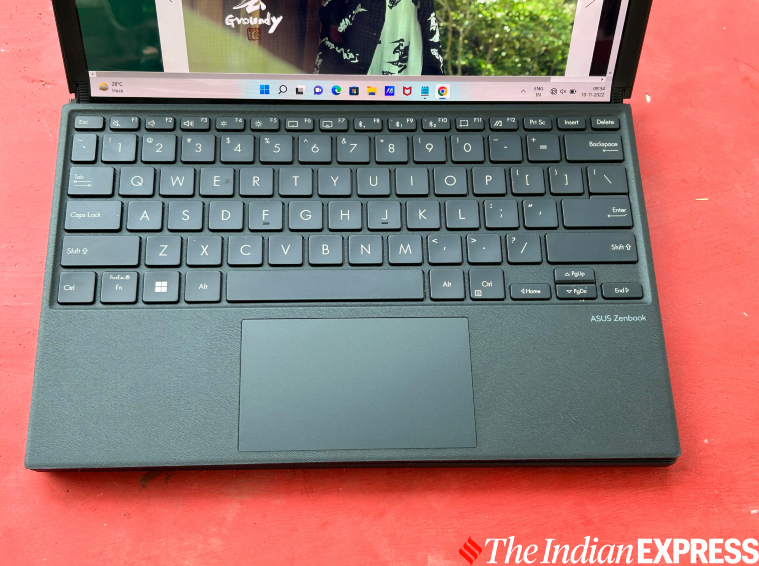
 The included keyboard can magnetically attach to the bottom half of the screen. (Image credit: Anuj Bhatia/Indian Express)
The included keyboard can magnetically attach to the bottom half of the screen. (Image credit: Anuj Bhatia/Indian Express)
Asus included only two Thunderbolt 4 USB-C (supporting up to 40 Gbps transfer speed) alongside a 3.5mm audio combo jack. A webcam is also included and can be found just left of the centre in the bezel around the screen. I do have a concern about the webcam, though. In the AIO desktop mode, which I used a lot during testing, the web camera placement shifts and this means you’ll show up sideways in video calls. Correct camera orientation can only be achieved in a laptop form factor.
Acceptable performance
My main purpose in using the ZenBook Fold was to see if it was better or near my MacBook Air M1 in performance. It served that well. With a 12th-gen Intel Core i7 U-series CPU, 16GB of RAM and a 1TB SSD, the Fold comes packing solid specs inside. There will always be a section of users who go for specs and benchmarks. I greatly admire the user base, but the ZenBook Fold is more of a lifestyle computer than a device designed as a video editor’s machine. The ZenBook Fold is a fast machine, but have I benchmarked it? No, when I spent my time juggling between my MacBook Air M1 and ZenBook Fold doing the same tasks day in and out, I could tell Asus’ computer was as good as Apple’s computer. Rarely have I felt the Fold struggling with average computing tasks.
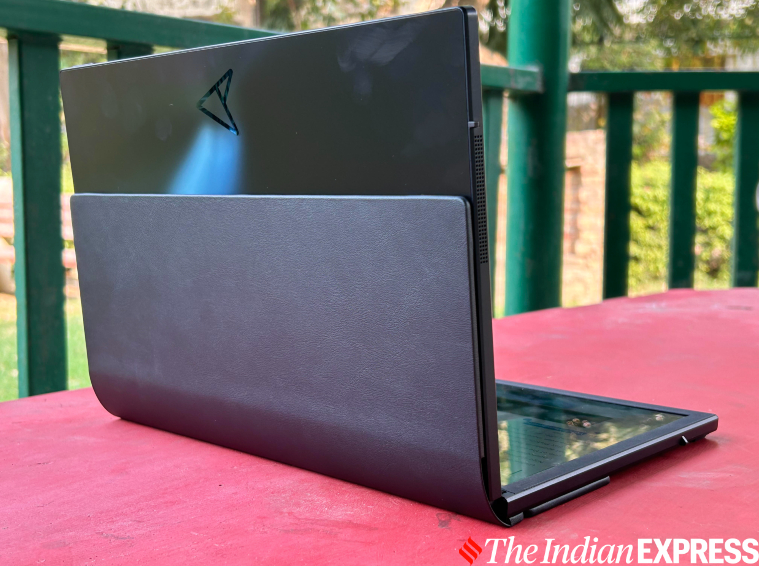
 A close look at the laptop’s hinge and the fold. (Image credit: Anuj Bhatia/Indian Express)
A close look at the laptop’s hinge and the fold. (Image credit: Anuj Bhatia/Indian Express)
To be clear, there is no dedicated graphics card, so don’t expect gaming or professional-grade editing capabilities on this machine. For those worried about battery life, there is good news. The battery on the ZenBook Fold lasted between 6 to 7 hours on a single charge, which is impressive for a device that has a 17-inch screen. What I didn’t like about the ZenBook Fold is the software running on this system: Windows 11. And while it’s not Asus’ fault completely, I feel Microsoft should have spent more time tailoring Windows for the new form factor and that is missing right now.

 There are multiple ways of using the ZenBook Fold. (Image credit: Anuj Bhatia/Indian Express)
There are multiple ways of using the ZenBook Fold. (Image credit: Anuj Bhatia/Indian Express)
Should you buy the ZenBook 17 Fold?
You may be wondering whether you need a foldable laptop and the answer is probably a no. But if you can afford one I think it offers an experience like no other device. Even though the ZenBook 17 Fold is still a first-generation product, I see a lot of potential in the foldable form factor if done right. The price can be a barrier for most people but, most importantly, I wanted the software experience to be on another level which is sadly not there as yet.
!function(f,b,e,v,n,t,s)
{if(f.fbq)return;n=f.fbq=function(){n.callMethod?
n.callMethod.apply(n,arguments):n.queue.push(arguments)};
if(!f._fbq)f._fbq=n;n.push=n;n.loaded=!0;n.version=’2.0′;
n.queue=[];t=b.createElement(e);t.async=!0;
t.src=v;s=b.getElementsByTagName(e)[0];
s.parentNode.insertBefore(t,s)}(window, document,’script’,
‘https://connect.facebook.net/en_US/fbevents.js’);
fbq(‘init’, ‘444470064056909’);
fbq(‘track’, ‘PageView’);


